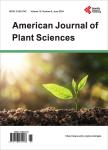The Cost-Benefit Analysis for Bananas Diversity Production in China Foc. Zones
The Cost-Benefit Analysis for Bananas Diversity Production in China Foc. Zones作者机构:不详
出 版 物:《American Journal of Plant Sciences》 (美国植物学期刊(英文))
年 卷 期:2011年第2卷第4期
页 面:561-568页
学科分类:1002[医学-临床医学] 100214[医学-肿瘤学] 10[医学]
主 题:Banana Diversity Foc. TR 4 Zone Cost-Benefit Disease Resistance
摘 要:Over 50 years ago, banana export plantations in Panama were ruined by Fusarium wilt race 1 (Foc. R1) since the popular cultivar Gros Michel is susceptible to Foc. R1 [1]. Fortunately, the resistant cultivar Cavendish replaced Gros Michel as the world biggest commercial fruit after ten years’ research and development. Due to its good economic profit, banana industry develops very fast recently in China. Unfortunately, Fusarium oxysporum f. sp. cubense tropical race 4 (TR4) brought disaster to Cavendish plantation since 1996. Most of traditional banana planting zones of Guangdong and Hainan provinces were infected by Foc. TR4 to the end of 2009. In order to fight against Foc. TR4, here we tried to investigate the cost-benefit and disease resistance of six banana cultivars (Cavendish Baxijiao, Dajiao, Guangfen No. 1, Fenzha No. 1, Gongjiao, Haigongjiao) planted in China Foc. Zones. Comparisons were conducted on their economic characteristics, cost, benefit, as well as the advantage and disadvantage and their application in rota-tion. Generally, supposing the investment of $ 4400/ha, the banana plantation attains a good economic profit as $ 2200/ha. Rotation of these cultivars can maintain the biodiversity as well as improve the sustainable development of banana industry.



